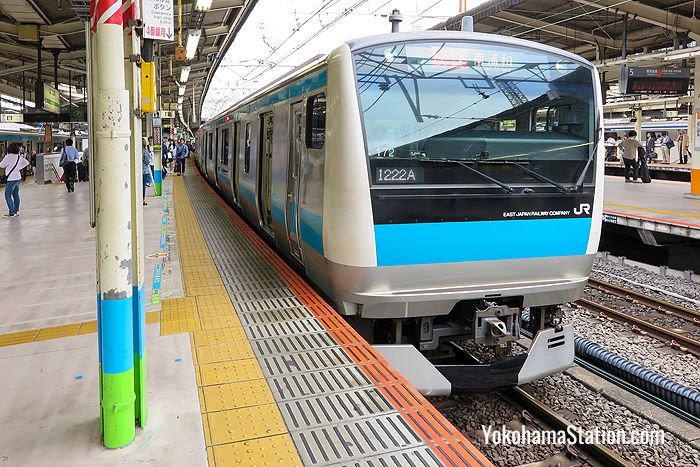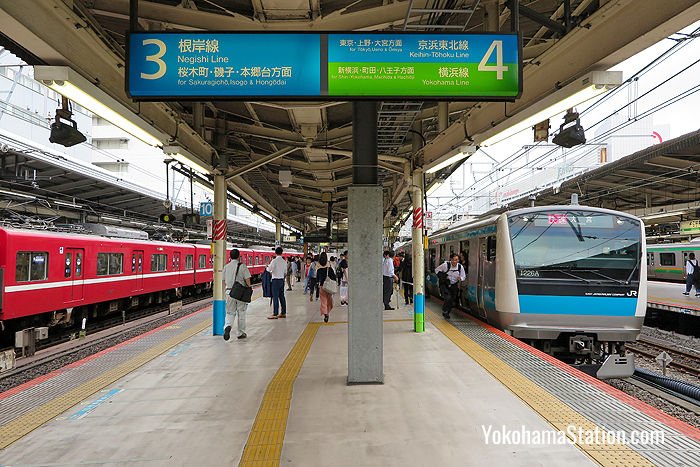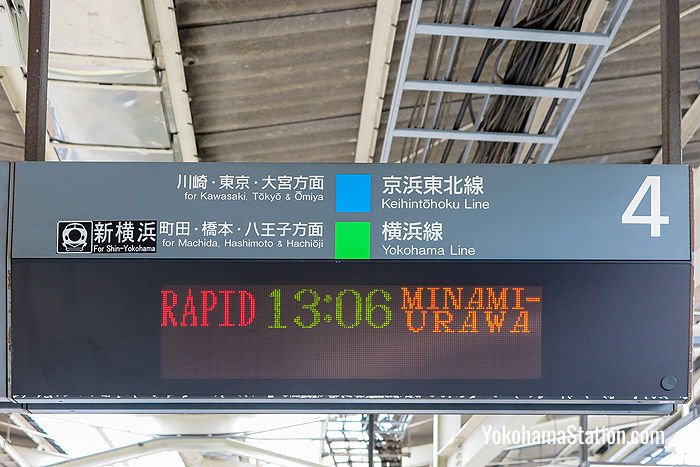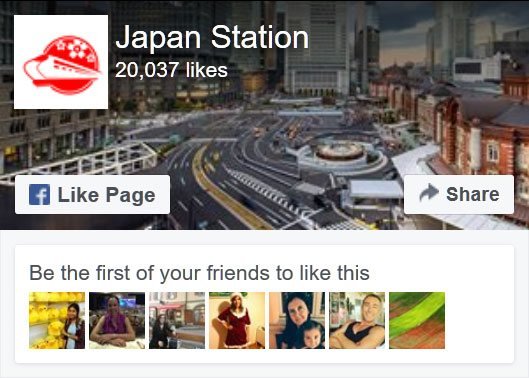The Keihin-Tohoku Line is a railway line operated by JR East that runs between Yokohama Station in Kanagawa Prefecture and Omiya Station in Saitama Prefecture. The line passes through Tokyo on the way between these destinations and within Tokyo it runs parallel to the Yamanote Line for a large part of its route.

A Keihin-Tohoku Line service at Platform 4, Yokohama Station
At Yokohama Station Keihin-Tohoku Line services depart from Platform 4. Yokohama Station is the southern terminus of the Keihin-Tohoku Line. However, southbound services on this line are mostly through services that continue on the Negishi Line as far as Ofuna Station. Negishi Line services depart from Platform 3. Both lines are fully covered by the Japan Rail Pass.

Platforms 3 and 4 at Yokohama Station
Key Destinations
There are 35 stations on the Keihin-Tohoku Line.
Yokohama – Higashi-Kanagawa – Shin-Koyasu – Tsurumi – Kawasaki – Kamata – Omori – Oimachi – Shinagawa – Tamachi – Hamamatsucho – Shimbashi – Yurakucho – Tokyo – Kanda – Akihabara – Okachimachi – Ueno – Uguisudani – Nippori – Nishi-Nippori – Tabata – Kami-Nakazato – Oji – Higashi-Jujo – Akabane – Kawaguchi – Nishi-Kawaguchi – Warabi – Minami-Urawa – Urawa – Kita-Urawa – Yono – Saitama-Shintoshin – Omiya
The key destinations on the Keihin-Tohoku are listed below with fares and example journey times given from Yokohama Station.

Departure information at Platform 4, Yokohama Station
Tsurumi Station
Sojiji Temple is a major Zen temple near Tsurumi Station. First founded in the year 740 in Ishikawa Prefecture, the temple was moved here in 1911 after a fire destroyed the original buildings. Temple tours with monks as guides or English language Zazen meditation sessions are both available here. The temple is a 7 minute walk west of the station.
Transfers can be made at Tsurumi Station to JR East’s Tsurumi Line and at nearby Keikyu Tsurumi Station to the Keikyu Main Line.
Train fare: 170 yen
Train time: 10 minutes
Kawasaki Station
Kawasaki is mainly an industrial city, but it has a number of attractions. Kawasaki Daishi is a popular temple complex dating from 1128. Japan Open Air Folk House Museum (Nihon Minka-en) is an architectural park with many traditional thatched minka farm houses. The Fujiko F. Fujio Museum is dedicated to the creators of the popular cartoon character Doraemon. Toshiba Science Museum is a free museum of interactive historical and technological displays which is just 5 minutes’ walk from Kawasaki Station.
Transfer here to the JR Tokaido Line, and the JR Nambu Line. At nearby Keikyu Kawasaki Station transfers can be made to the Keikyu Main Line, and the Keikyu Daishi Line.
Train fare: 220 yen
Train time: 14 minutes
Omori Station
This station is convenient for Shinagawa Historical Museum. The museum is dedicated to local history and displays archaeological finds from the nearby Omori Shell Mounds. Also on display are exhibits related to the Shinagawa Post Station which was the first stop on the old Tokaido highway that connected Tokyo (then called “Edo”) with Kyoto. Omori Shell Mounds Park is an 8 minutes’ walk north of Omori Station and the museum is a 7 minutes’ walk north of the park.
Train fare: 300 yen
Train time: 22 minutes
Shinagawa Station
Exit here for Sengakuji Temple where the legendary 47 Ronin lie buried. These heroic 18th century samurai are famous for their loyalty and a festival is held here every December 14th to celebrate their memory. There are also a large number of museums in this area. The Nikon Museum has many interactive displays detailing the history, technology and design principles of the Nikon company and a “hands-on” section exhibiting rare and valuable cameras. The Hara Museum is housed in a Bauhaus building dating from 1938 and is dedicated to contemporary art, architecture, design, music and dance. The Jade Ore Museum exhibits a large private collection of jade pieces cut and uncut and many of the displayed pieces are for sale. The Hatakeyama Memorial Museum of Fine Art exhibits a collection of Japanese, Chinese, and Korean art related to the tea ceremony.
Transfers at Shinagawa Station to the JR Yamanote Line, the JR Yokosuka Line, the JR Tokaido Line, the Tokaido Shinkansen, and the Keikyu Main Line.
Train fare: 300 yen
Train time: 29 minutes
Hamamatsucho Station
Exit here for two of Tokyo’s most famous gardens: the Kyu Shiba Rikyu Garden and Hamarikyu Gardens. Also nearby is Zozoji Temple, an impressive Buddhist temple founded in 1393, which holds the tombs of six Tokugawa shoguns. The temple’s main gate dates from 1622 and is Tokyo’s oldest wooden building. Just beyond Zozoji is Tokyo Tower, which at 332.9 meters high is the second tallest structure in Tokyo. Inside the tower are viewing platforms, souvenir shops, cafes, restaurants, and a theme park based on the One Piece manga series.
Transfers here to JR East’s Yamanote Line and the Tokyo Monorail. At nearby Daimon Station transfers can be made to the Toei Asakusa Line and the Toei Oedo Line.
Train fare: 480 yen
Train time: 35 minutes
Shimbashi Station
Shimbashi Station is an important stop for railway enthusiasts. The first Shimbashi Station opened in 1872 as the Tokyo terminus of Japan’s first railway (which ran between Shimbashi and Yokohama). This building has been reconstructed in its original location as Old Shimbashi Station (5 minutes east of the current station building). Inside is a museum with displays of railway history. Outside the west side of the present Shimbashi Station is a popular meeting point called SL Square where is a Class C11 steam locomotive dating from 1945 is on display.
Transfers can be made at Shimbashi Station to the following JR services: the Yamanote Line, the Tokaido Line, and the Yokosuka Line. Transfers can also be made to the Tokyo Metro Ginza Line, the Toei Asakusa Line, and New Transit Yurikamome.
Train fare: 480 yen
Train time: 37 minutes
Yurakucho Station
This station is convenient for the convention center and performance venue Tokyo International Forum. Outside the station and under the rail tracks is the lively Gadoshita area which is packed with cheap diners and drinking venues.
Transfer here to JR East’s Yamanote Line, Tokyo Metro’s Yurakucho, Hibiya, and Chiyoda lines, and the Toei Mita Line.
Train fare: 480 yen
Train time: 39 minutes
Tokyo Station
Attractions close to Tokyo Station include the gardens of the Imperial Palace, and Mitsubishi Ichigokan Museum. The museum is housed in a Queen Anne style building designed by Josiah Conder and exhibits mainly 19th century European art. Outside the western Marunouchi Exit of Tokyo Station you can view its original red brick façade which dates from 1914. The eastern Yaesu Exit of the Tokyo Station building is more contemporary in appearance and opens onto the Tokyo Station City shopping and dining complex.
The Tokyo Station Hotel is an iconic, luxurious establishment seamlessly integrated into the historic Tokyo Station building, offering convenient access to transportation and a blend of classic elegance with modern amenities.
Tokyo Station is a major interchange station with both regular lines and several shinkansen services. Transfers can be made here to JR East’s Yamanote Line, Chuo Main Line, Sobu Main Line, Yokosuka Line, Keiyo Line, and Tokaido Main Line. Transfers can also be made to the following bullet train services: the Tokaido Shinkansen, the Tohoku Shinkansen, the Joetsu Shinkansen, the Yamagata Shinkansen, the Akita Shinkansen, the Hokuriku Shinkansen, and the Hokkaido Shinkansen. Transfers can also be made here to the Tokyo Metro Marunouchi Line. Highway bus terminals can be found outside the Yaesu Exit.
Train fare: 480 yen
Train time: 42 minutes
Kanda Station
Exit here for Mitsui Memorial Museum which exhibits the Mitsui family’s collection of Japanese and East Asian art treasures.
Transfer here to JR East’s Yamanote Line and Chuo Line, and the Tokyo Metro Ginza Line.
Train fare: 570 yen
Train time: 44 minutes
Akihabara Station
The Akihabara district is world-famous for its cheap electronics stores, as well as shops catering to “otaku” culture with manga, anime, games, and cosplay goods. Here you can also find maid cafes where customers are served by girls in French maid costumes.
Transfer here to JR East’s Yamanote Line and Chuo-Sobu Line, the Tokyo Metro Hibiya Line, and the Tsukuba Express.
Train fare: 570 yen
Train time: 46 minutes
Okachimachi Station
Exit here for the southern entrance to Ameya-Yokocho: a busy street market with a huge variety of cheap eateries and bargain stores.
There are four stations in this area which are very close together. Transfer at Okachimachi Station to JR East’s Yamanote Line. At Ueno-Okachimachi Station transfer to the Toei Oedo Line. At Ueno-Hirokoji Station transfer to Tokyo Metro’s Ginza Line. At Naka-Okachimachiand transfer to Tokyo Metro’s Hibiya Line.
Train fare: 570 yen
Train time: 48 minutes
Ueno Station
Ueno is a popular sightseeing location with many cultural facilities and historical sights contained inside Ueno Park. Highlights include the world-class art collections of Tokyo National Museum and the National Museum of Western Art, the amazing displays of technology and natural history at the National Museum of Nature & Science and the giant pandas of Ueno Zoo. The northern entrance to Ameya-Yokocho street market can also be accessed here.
Ueno Station is an important transportation hub with connections to JR East’s Yamanote, Utsunomiya, Takasaki, Joban, and Ueno-Tokyo lines; the Tohoku, Yamagata, Akita, Joetsu, Hokkaido and Hokuriku shinkansen services; Tokyo Metro’s Ginza and Hibiya lines; and the Keisei Main Line.
Train fare: 570 yen
Train time: 50 minutes
Nippori Station
This station is convenient for the traditional shopping street of Yanaka Ginza, the popular cherry blossom viewing spot of Yanaka Cemetery, and Tennoji Temple which was founded 1274 and features a large bronze statue of the Buddha which dates from 1690.
Transfer at Nippori Station to JR East’s Yamanote Line and Joban Line, the Keisei Main Line, and the Nippori-Toneri Liner.
Train fare: 570 yen
Train time: 54 minutes
Tabata Station
In the early 20th century, Tabata was home to a community of celebrated artists, novelists and poets. Among these the writer Akutagawa Ryunosuke was probably the most famous and so he was nicknamed “the king of Tabata”. Today this history is celebrated at the Tabata Memorial Museum of Writers and Artists which holds 3,000 objects including paintings, ceramics, letters and original manuscripts. Admission is free and the museum is a 2 minute walk from Tabata Station.
Transfer at Tabata Station to JR East’s Yamanote Line.
Train fare: 650 yen
Train time: 57 minutes
Kami-Nakazato Station
Exit here for Kyu-Furukawa Gardens, a Western style manor house built in 1917 which is surrounded by park land. The gardens include a rose garden, a rhododendron garden, and a traditional Japanese stroll garden and pond.
Train fare: 650 yen
Train time: 1 hour
Oji Station
Just outside Oji Station is Asukayama Park which is known for its springtime cherry blossoms. Inside the park are three museums. The Paper Museum has exhibits related to 2,000 years of paper history including traditional Japanese washi paper, the development of industrial paper manufacturing, paper recycling and associated environmental matters. The Shibusawa Memorial Museum is dedicated to the Meiji era industrialist Shibusawa Eiichi. The Asukayama Museum is dedicated to local art, culture and history. Also in the park are two preserved railway vehicles: a D51 steam locomotive which was retired in 1972 and an old Toden Arakawa Line tram car which was retired in 1978.
North west of the station are two shrines: Oji Jinja Shrine which is most famous for its giant Gingko tree, and Oji Inari Jinja Shrine which is a legendary gathering place for fox spirits. Every year from midnight on New Year’s Eve an annual costume parade of people wearing fox masks is held from nearby Shozoku Inari Jinja Shrine to Oji Inari Jinja Shrine to celebrate the New Year. Just north of Oji Inari Jinja is Nanushinotaki Park, a traditional Japanese stroll garden which is free to enter.
Transfer at Oji Station to Tokyo Metro’s Namboku Line and the Toden Arakawa Tram Line.
Train fare: 650 yen
Train time: 1 hour and 2 minutes
Kawaguchi Station
Exit here for the park and botanical garden at Kawaguchi Green Center, and the Former Tanaka Family Residence: a Taisho era red-brick building which features an interesting blend of Japanese and Western styles of architecture.
Train fare: 730 yen
Train time: 1 hour and 10 minutes
Kita-Urawa Station
Exit here for the Museum of Modern Art, Saitama (MOMAS). Loctaed in Kita-Urawa Park, MOMAS was designed by the Metabolist architect Kisho Kurokawa and it exhibits works by leading international and Japanese artists.
Train fare: 940 yen
Train time: 1 hour and 25 minutes
Saitama-Shintoshin Station
Exit here for Saitama Super Arena, which is a popular venue for sporting and musical events.
Transfer here to JR East’s Utsunomiya Line and Takasaki Line.
Train fare: 940 yen
Train time: 1 hour and 29 minutes
Omiya Station
Omiya’s attractions include Hikawa Shrine (which is believed to be 2,400 years old), Omiya Railway Museum, Omiya Bonsai Village, the Japan Mint Museum, and Saitama Prefectural Museum of History and Folklore.
Omiya is a major transportation hub in Saitama Prefecture. Transfer here to the Tobu Urban Park Line, Saitama New Urban Transit’s “New Shuttle” on the Ina Line and the following JR lines: the Utsunomiya Line, the Takasaki Line, the Shonan-Shinjuku Line, the Saikyo Line and the Kawagoe Line. The following shinkansen services all run from Omiya Station: the Tohoku Shinkansen, the Yamagata Shinkansen, the Akita Shinkansen, the Joetsu Shinkansen, and the Hokuriku Shinkansen.
Train fare: 940 yen
Train time: 1 hour and 32 minutes
Useful Links
To plan your journey via the Keihin-Tohoku Line use English language route finders like the Japan Transit Planner or Hyperdia. JR East has a PDF route map of their railway network in which the Keihin-Tohoku Line and Negishi Line are together numbered 4 and colored light blue.
Article and original photos by Michael Lambe. All rights reserved.
